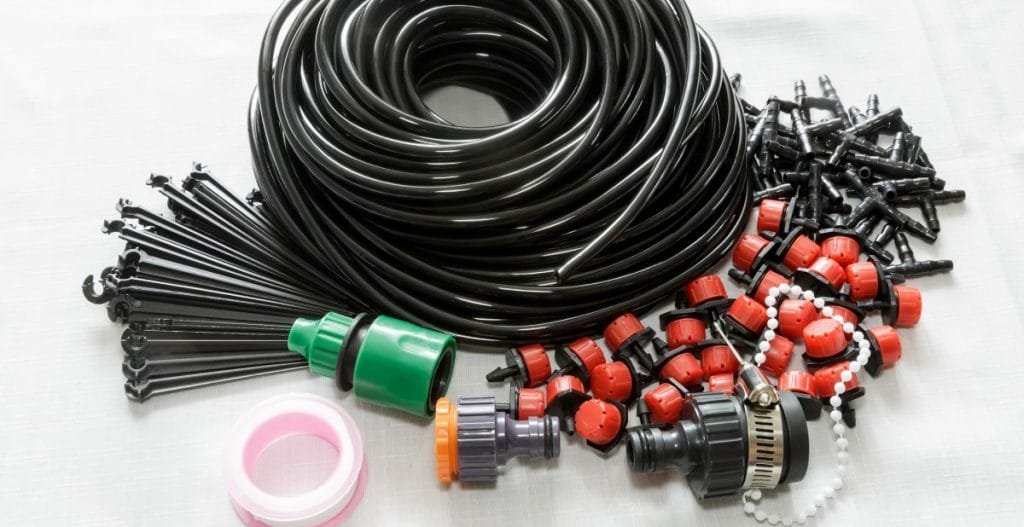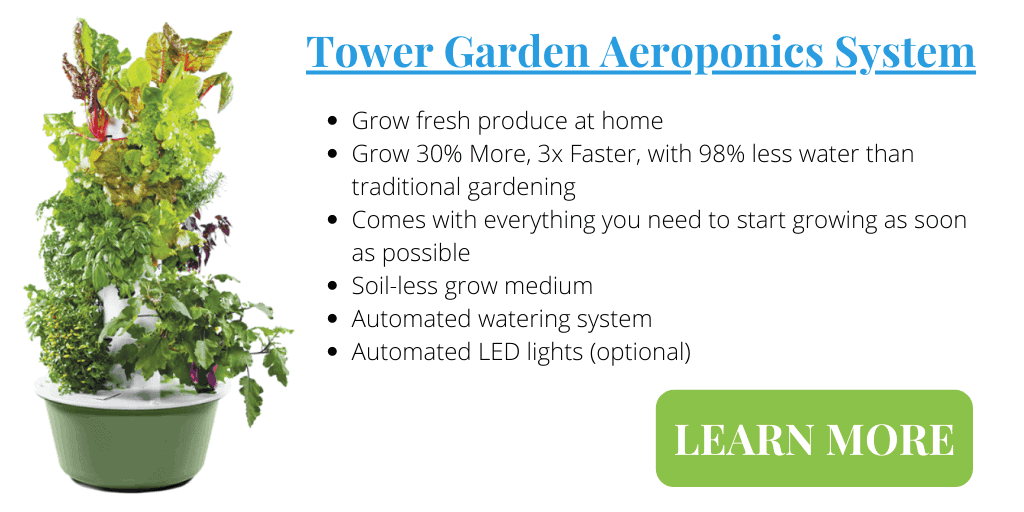Drip hydroponics is a water-efficient hydroponics system that many hydroponics growers implement. The system is fairly simple and can be used in locations where electricity to drive pumps is unreliable or not available. How do hydroponic drip systems work, and is it the right hydroponic implementation for you?
A hydroponic drip system uses a system of pipes and drippers or emitters to deliver a controlled amount of water and nutrients directly to the root area of the plants. The system is water-efficient, cost-effective, versatile, and scalable to meet most gardeners’ growing space and requirements.
Hydroponic growing has many advantages and many different implementations of the principles. Each hydroponic system has advantages that make them suitable for specific situations but inappropriate for others. Understanding drip hydroponics will help you decide if this system has benefits for your growing circumstances.

What Is Drip Hydroponics?
Drip hydroponics is known by various names, including trickle irrigation, micro-irrigation, and localized irrigation.
The principles of drip systems can be implemented for in-ground growing and in pots, raised beds, and other soil-based growing methods.
Our focus here will be on hydroponic drip systems, which, by definition, are soil-less growing systems.
Drip hydroponics is a highly water-efficient hydroponic implementation and gives the gardener precise control over water and nutrient delivery to the plants.
The drip system is flexible and scalable, making it easy to adapt the system to many varying circumstances.
How Does Drip Hydroponics Work?
Drip hydroponics works by storing the nutrient-laden water in a central reservoir. The plants can be planted in any supporting structure using rock wool, perlite, vermiculite, coconut coir, or any other hydroponic growing substrate.
The nutrient-laden solution is delivered to the plants via small diameter pipes with drippers or emitters depositing the liquid close to the plants’ roots.
The drip system can be a recirculating system, where unused nutrient water filters through the growing medium and is drained back to the main nutrient reservoir. This is a less common implementation since most growers tweak their drip system to only deliver the amount of nutrients the plants will use.
The mechanism to deliver the nutrient water from the reservoir to the plants can be pump-driven. In simple implementations, gravity-fed systems can be installed that do not require a pump or electricity.
As with all hydroponic systems, advantages offer benefits for the system implementation, and certain negative aspects of the system make it unsuitable for some growers.
I’ve had the most success growing fruit and vegetables at home using the Tower Garden vertical aeroponic system. The system was shipped to my door with everything I needed to get started growing and I was able to set it up in under an hour.
The vertical tower lets me grow 20+ plants in the corner of my home office or on my outside patio in the summer. I grow a large portion of my families greens, herbs and tomatoes and it only takes a few minutes a week to maintain the garden. Find out more about What is a Tower Garden and how does it work.

Pros And Cons of Drip Hydroponics
Drip hydroponics is a fairly popular form of hydroponics because it can be as simple or as complex and sophisticated as you want to make it.
All hydroponic systems have strong points and weaknesses, and drip hydroponics is no different. The pros of the system may persuade you that this is the right hydroponic system choice for you, or the cons may result in looking for a different system.
Most hydroponic growers use multiple growing systems to leverage the advantages of each system type to their advantage.
For example, a gardener may have an outdoor hydroponic system for summertime growing but a vertical indoor drip hydroponic system for growing during the winter season.
Check out my recent article on indoor vertical garden tips for more information.
Drip Hydroponic System Pros
The main advantages of the hydroponic drip systems that make it a popular growing method are as follows.
- Drip hydroponics is water-efficient. Drip hydroponics is one of the most water-efficient hydroponic systems because it only delivers the amount of water the plants will use. This reduces water loss to evaporation and excess watering.
- Efficient nutrient use in drip hydroponics. Drip hydroponics only delivers nutrients the plant needs, avoiding nutrient loss and lowering nutrient costs.
- Drip systems improve plant nutrient take-up. The nutrients are delivered directly at the plants’ root area, making it easy for the plants to absorb the nutrients and increase their nutrient availability.
- Drip hydroponics is simple. Drip hydroponics can be a simple or a complicated installation. Creating a simple setup makes it accessible for anyone to establish a food garden.
- Low cost to implement. Drip hydroponics does need some specialized equipment, but it is not expensive. With a little innovation, you can create a drip system from items you have at home. Choosing to implement technology in the system is possible but will increase the initial setup cost.
- Hydroponic drip systems are scalable. Most drip hydroponics can be implemented on a small scale or a large scale. Many of the systems are modular, allowing you to start small and expand the system as your experience or needs increase.
- The versatility of drip hydroponics. Drip systems can be implemented in horizontal or vertical growing formats, offering options for those with space constraints.
- Higher level of control with drip hydroponics. Drip hydroponics allows you to control the amount of water and nutrients delivered to each plant. The control can be manual by controlling each dripper rate or centralized, using timers
You can get all the details about hydroponic nutrients here in my newly finished guide.
Hydroponics Drip System Cons
Before deciding if a drip system matches your needs, you need to be aware of some potential problems and issues with drip hydroponics.
The main issues to be considered as cons for a drip hydroponics installation are as follows.
- Kinks in drip hydroponics pipes. Drip hydroponics uses small diameter pipes to deliver the nutrients to each plant. Some of the tubing for these pipes is flexible and soft, posting the risk of kinks or pinching of the tubes, which will restrict nutrient flow to the plant.
- Blockages in drip hydroponic systems. Drippers or emitters and the narrow diameter pipes can become blocked by obstacles or build-up of salts and minerals from the nutrients. These blockages can result in restricted flow to the plants. A complete blockage will stop delivery, starving the plant and causing stress or even death of the plant.
- Plants can dry out quickly. Since drip hydroponics only delivers the water and nutrients the plant needs, a loss of water delivery from a blockage or a pump or electricity outage can cause your plants to die quickly. The substrate will sustain them for a short time with the nutrients they have absorbed, but it will dry out fast.
- Pressure problems with drip hydroponics. Gravity-fed drip hydroponics can take some tweaking to get the pressure in the system correctly set up to reach plants at the far end of the system.
The Gear You Need For A Drip Hydroponic System
The main items needed for a drip hydroponic system are minimal and relatively cheap. A small system can be set up for under $50, especially if you repurpose items you may already have at home.
The first step in implementing your hydroponic drip system is to decide on your growing layout and get the plant containers ready. You must get this layout done first since it will determine the length of piping you will need to position the drippers.
The layout for your drip growing system can be horizontal or vertical. Use a horizontal layout if you have ample space or a vertical system if your space is limited.
Check out my guide to vertical gardening to help decide if growing vertically is right for you.
Drip hydroponic systems generally require pipes of two diameters; a larger diameter pipe to take nutrients from the nutrient reservoir to the plants and a smaller diameter feeder pipe that taps into the main line to direct water to the individual drippers for the plants.
You can manage with a single diameter pipe from the nutrient reservoir and fit the dripper directly to the main water line in simple systems.
The diameter of each of these pipes will be determined by the size of your nutrient outlet and the diameter the drippers or emitters will accept for a watertight connection.
- PRODUCT PACKAGING: 30 - meter drip irrigation tube (2 specifications), 30 drip tips (3 styles),...
- EASY TO INSTALL: The drip irriagtion kit comes with two types faucet fittings, a threaded and a...
- AUTOMATIC PLANT WATERING: The drip irrigation system kit takes care of every plant you irrigate...
Emitters are a fancy name for drippers, and they are one and the same. Some emitters are a single volume flow, while others are adjustable. You will need a range of drippers to allow you to modify the flow rate according to the needs of the plants you grow in the system.
The reservoir to hold the nutrient water can be any plastic container with sufficient volume to supply nutrients to feed your plants for at least a week. Many people use 20-gallon buckets for this purpose, but any clean, food-grade plastic container will suffice.
A pump will be needed for all non-gravity drip systems. We recommend using a submersible pump in the nutrient reservoir to deliver a predictable water pressure for beginners. See my review of submersible hydroponic water pump problems and fixes.
Pressure issues in gravity-fed systems can be difficult to manage, especially for people new to this type of system. Gravity-fed systems also require the nutrient reservoir to be elevated, which increases the difficulty of filling the system with fresh nutrients.
A timer is generally used in tandem with an electric pump to initiate a watering cycle and switch off the system when the watering is complete. The timing of the watering and dry cycles will depend on your plants’ requirements and your environmental conditions.
- Bluetooth Balcony Irrigation System This bluetooth programmable irrigation kit can be...
- Substantial Water Savings Our autopot watering systems are ideal and smart to help you save...
- Micro Drip Irrigation System We’ve designed this self-watering irrigation system to be ideal...
What Is The Best Growing Medium For Drip Hydroponics?
There are several choices for a growing medium for hydroponic drip systems, and the layout of your growing system will largely govern your choice.
A growing medium such as perlite would suit dutch bucket systems, while rock wool makes a great growing medium for net pots systems.
The main feature to consider for the growing medium is its water retention capacity. The material must be able to hold sufficient moisture to prevent the plant roots from drying out too quickly and limiting the frequency of watering.
Can You Use Drip Hydroponics Indoors And Outdoors?
Drip hydroponics is versatile and can be implemented both indoors and outdoors. It can be used in horizontal gardens, tiered growing systems, and vertical gardens. The pipes are flexible and can be configured to any shape and layout to fit your available space.
Vertical gardens are popular for indoor growing due to the lower space requirements but can also be used outdoors where space is limited. Indoor hydroponic drip systems will require additional lighting to supplement natural light, especially if you grow vegetables that need 6 to 8-hours of light per day.
Horizontal gardens are more appropriate for an outdoor location because of the floor space required by the system. However, these systems can be compact enough to be applied to limited outdoor space, allowing you to give your plants as much natural sunlight as possible.
Scalability is another important aspect of drip hydroponics that makes it suitable for almost any growing location. They can be constructed to be small enough to take up a small amount of space in the corner of a room or expanded to utilize your entire backyard!
The system’s scalability makes it popular for hobby growers and commercial growers alike, customizing the system for the available space and the growing need.
What Plants Can You Grow With Drip Hydroponics?
The versatility of hydroponic drip systems does not stop with the benefits for different locations and scalability. The variety of plants you can grow in drip systems is greater than in many other hydroponic systems.
The flexibility of the plant arrangements and the sizes of the containers the plants can be grown in means that you can grow a wide range of plants, from small plants and leafy greens to root crops, if you configure your systems properly.
The plant types you can grow in your drip hydroponics will be dependent on your space, growing medium, and growing layout.
Vertical growing has some limitations to the size of the plant you can incorporate into the system, while horizontal growing and dutch bucket growing offer space to grow larger plants, including fruit trees.
The type of growing medium you use in your system will determine the support offered to the plants. Large plants need a more substantial growing medium such as perlite, while smaller plants such as lettuce will grow well in coir or rock wool substrates.
Beginners to drip hydroponics should start with easy-to-grow plants such as lettuce, swiss chard, mint, and other herbs.
Easy plants to grow in drip hydroponics include the following.
- Lettuce
- Cabbage
- Swiss chard
- Spinach
- Leeks
- Mint
- Basil
- Dill
Larger plants that grow well in drip hydroponics but are still easy to grow include the following list.
- Tomatoes
- Beans
- Peas
These plants will require some vertical space and require staking or trellising to support their structure.
Ground cover plants can also be grown using drip hydroponics if you have the space for the plants to sprawl around the growing container. The following spreading plants are examples that grow well in drip systems.
- Butternut squash
- Pumpkin
- Cucumbers
- Strawberries
- Melons
Root crops are a little more difficult to grow, but you can include the following root crops in your gardening repertoire with the right substrate.
- Radishes
- Carrots
- Beets
- Onions
Other plants that are typically more difficult to grow in hydroponic systems, such as chilies and bell peppers, can also be successfully cultivated in drip hydroponic systems.
Conclusion
Drip hydroponics is a versatile, water-efficient system that anyone can use to grow food for themselves and their family. The drip system can be as small or as large as you like and can be scaled to meet your needs or expanded as your needs increase or your confidence grows.
The relatively low cost of hydroponic drip systems is another attractive characteristic that makes it an ideal starting point for those wanting to wet their feet in the world of hydroponics!


